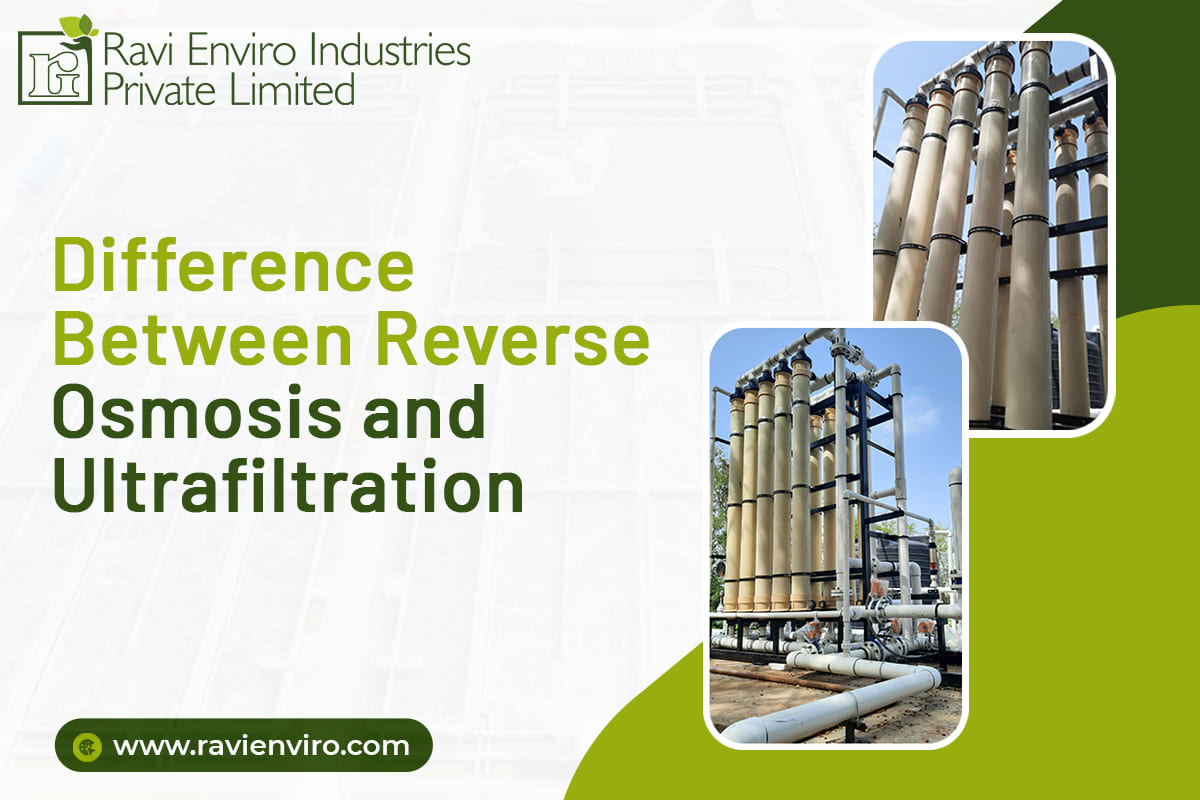
- Jul 9, 2024
- Ravi Enviro
- RO Plant, ultrafiltration (UF)
- 0 Comments
With various water filtration systems, reverse osmosis and ultrafiltration are two of the most popular and effective processes. These water treatment systems offer deep purification with specialized filtration materials. RO and ultrafiltration work great against contaminants, suspended particles, and impurities larger than thier pore sizes. While both RO and UF processes have impressive filtration properties, there are many key differences between both filtration systems. In this blog, we explore the difference between reverse osmosis and ultrafiltration systems, helping you choose the right WTP for your specific application.
Reverse Osmosis vs Ultrafiltration
The role of both water filtration plants is mainly to eliminate impurities in the water by forcing the water through a filtration media of a particular pore size. The filtration media can be clay, gravel, sand, or activated carbon.
What is Ultrafiltration?
The ultra filtration water treatment plant pushes the water through a membrane. Its physical filtration process depends on home water pressure and a semipermeable membrane. Once the water is forced through the ultrafiltration membrane, contaminants and impurities bigger than the membrane pore size are eliminated. Pore size of UF membrane is 0.01 microns
What is Reverse Osmosis?
The RO water treatment plants effectively remove impurities, contaminants, viruses, and bacteria. The pore size of RO filters is nearly 0.001 microns making it effective in removing different types of pollutants along with microelements like calcium, magnesium, and sodium.
What is the Difference Between UF and RO Plants?
Pore Size
The primary difference between reverse osmosis and ultrafiltration is membrane size. RO membranes have relatively smaller pores when compared with ultrafiltration membrane pores. The RO membranes have micropores that effectively remove microscopic contaminants, including molecules and ions, allowing only water molecules to pass. The ultrafiltration membrane has large pores ranging from 0.01 to 0.1 micrometers, which allows the removal of particles and contaminants.
Water Storage and Conservation
Reverse osmosis is a cross-flow filtration system. This type of water filtration system creates two streams viz the membrane. One stream leads to the water storage tank, and the other to the drain. The RO system must be hooked to the drain as the impure water must be flushed out. Ultrafiltration plants do not need a water storage tank as it is directly connected to a faucet.
Pressure Requirements
The reverse osmosis system needs higher operating pressure as compared to the UF plants. The RO plants depend on major hydraulic pressure to force water through the semipermeable membrane to separate it from contaminants and dissolved solutes. RO system needs range from 50 to 1200 psi (pounds per square inch). The UF system needs lower pressure, making it an energy-efficient alternative. It operated at a pressure ranging from 5 to 50 psi.
Mineral Removal
Another difference between UF and RO systems is the capacity to remove minerals. The reverse osmosis plants remove minerals, while UF plants retain minerals. The industrial RO plant manufacturer in India designed these plants to filtrate selectively, allowing only water molecules to pass through while restricting minerals, salts, and other contaminants. In contrast, the large pores of the UF plants allow the passing of minerals while effectively blocking microbes and large particles.
Applications
The RO systems are ideal for producing drinking water. The UF systems are used as pre-filters in the reverse osmosis systems. The RO plants are used for drinking water in industrial, residential, commercial, and industrial settings. Ultrafiltration is used for wastewater treatment in different industries.
Conclusion
This was the comprehensive difference between ultrafiltration and reverse osmosis. Both systems have excellent filtration properties and robust and effective WTP plants. Ravi Enviro Industries Private Limited is a leading water treatment plant manufacturer in India. We believe that valuable water can be recycled and reused through innovative water treatment systems. We provide a range of water treatment solutions, including effluent treatment plants, sewage treatment plants, industrial RO plants, UF plants, Zero liquid discharge plants, and other turnkey services and products. If you want to install WWTP plants or need water treatment plant maintenance services, reach out to us at +91-265-2646554 or info@ravienviro.com



